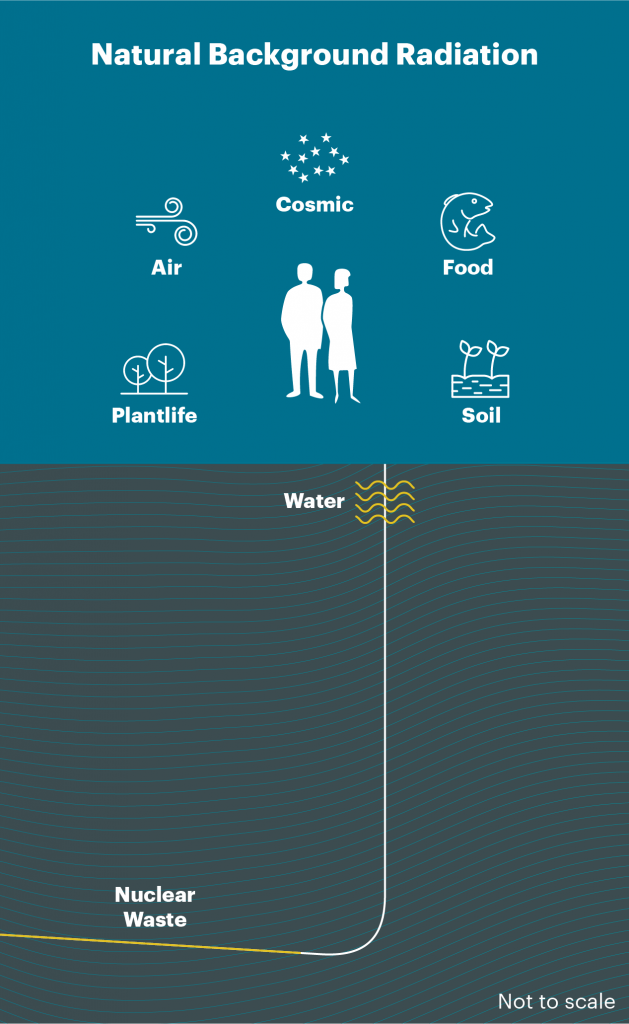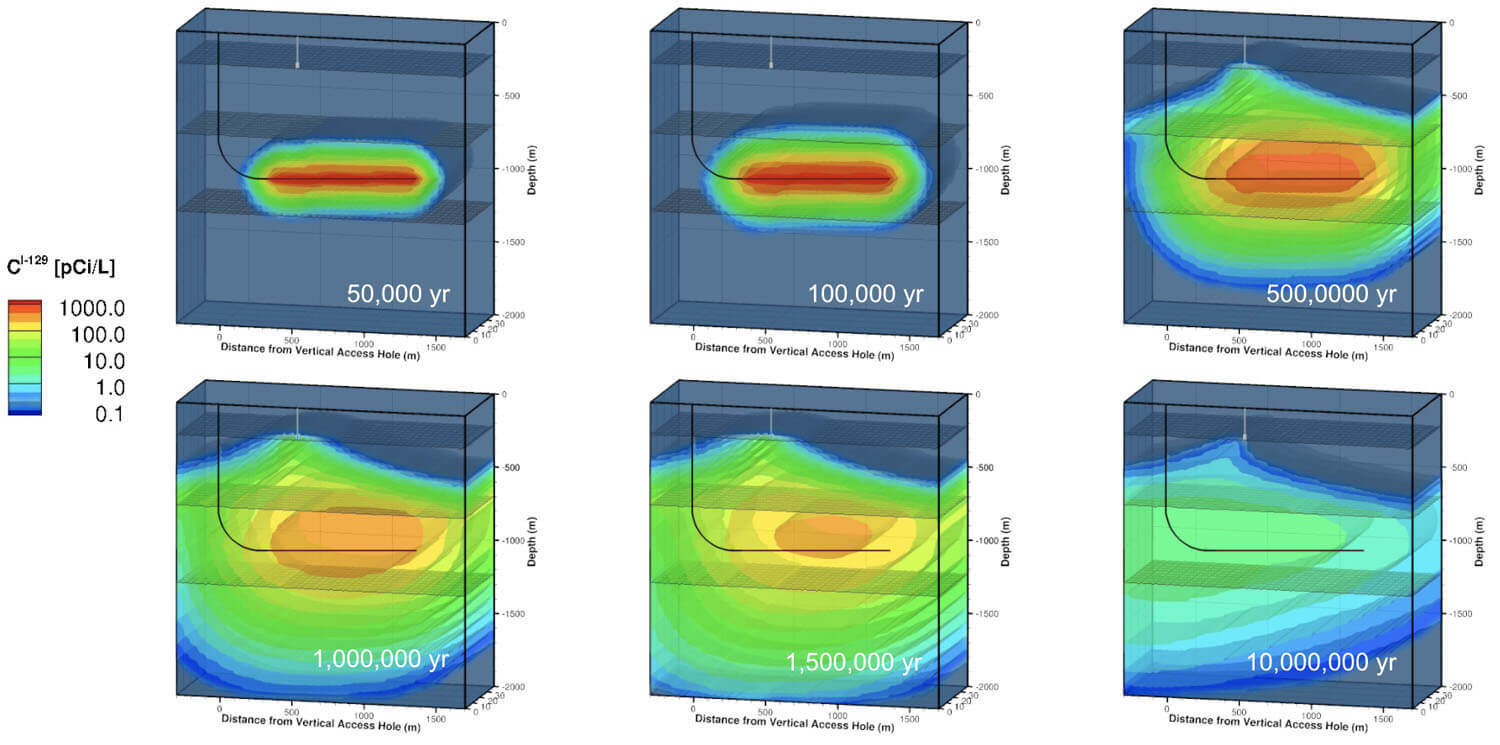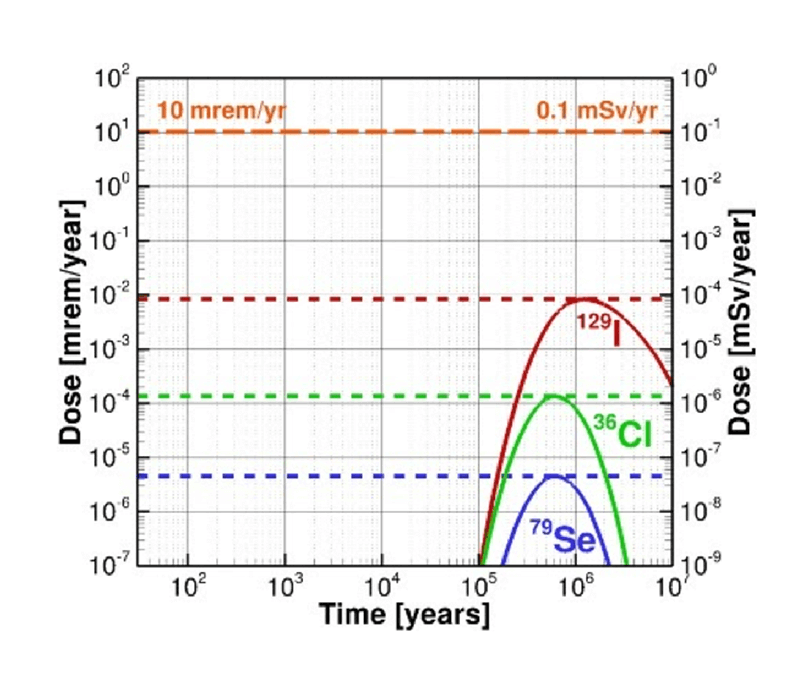Deep Isolation is committed to the safety of people and the environment and is actively developing deep borehole disposal technology to achieve enhanced safety and long-term isolation of nuclear wastes. Deep Isolation conducts safety calculations for various directional borehole repository concepts and uses the results to improve and optimize its design for nuclear waste disposal safety.
Nuclear Waste Disposal Safety Factors

ste may reach aquifers near the surface in small concentrations. Deep Isolation’s safety analysis approach assesses these transport rates and pathways and aims to provide very high confidence that the concentrations of radionuclides near the surface are sufficiently low that they pose no significant harm to humans and the environment.
Barriers and factors that affect groundwater movement in potential host rock include:
- How radioactive particles dissolve and are dispersed in the fluids contained in a host rock (pore fluids).
- How long it takes fluid to move from the repository into the host rock and potentially to the surface.
- The interaction and tendency of radioactive particles to get stuck (sorb) to the host rock as the underground fluids are forced through pores and cracks in the rock.
- Natural or repository-induced factors that may exist or be generated in the deep subsurface driving movement of contaminated groundwater toward the surface over the long term.
Geologic layers considered suitable to host a repository for nuclear waste should be very tight, that is, groundwater flows extremely slowly through the small pores of the rocks, effectively isolating the waste for a very long time.
Radiation Dose
Ultimately, the main performance measure for deep geological repositories is the maximum annual dose of radiation to a person at the surface. This is because groundwater movement poses a possible exposure pathway to drinking water from wells that might exist above the repository.
To demonstrate that Deep Isolation’s disposal options would meet an annual radiation dose limit of 10 mrem per year (far less than typical background radiation), multiple sets of post-closure radiological safety calculations have been completed and published.
What are safety calculations?
Our safety calculations assess the performance of a deep borehole repository both in the short and long term using a numerical modeling system. Radiation dosage is calculated from 400+ realizations of randomly sampled and combined parameter sets over a period of 1 million years.
Two Barrier Systems
Safety calculations quantify how well the natural underground environment paired with human-made engineered barriers work to separate nuclear waste from the surface environment and its inhabitants. In the short term, the engineered barriers of a repository (e.g., waste canisters and sealing materials) provide redundant mechanisms for containing nuclear waste or slowing its rate of transport. In the long term, the geologic properties of the host rock and depth of disposal act as the primary barrier to ensure that the harmful radionuclides do not reach the surface and humans.
Calculations of Natural Barrier System
Suitable sites will be natural, deep geologic environments that have reliably demonstrated isolation of fluids on a time scale similar to that required for radioactive waste disposal. The combination of depth and stability of the host rock will significantly delay the migration of radioactive particles moving up through the rock, ensuring that the harmful radionuclides decay before they can reach the surface.
Deep Isolation conducted safety calculations for a generic deep horizontal borehole repository sited in shale, as well as a generic vertical borehole repository in crystalline basement rock. Using iterative computer simulations exploring a range of possible properties and scenarios, we are able to predict the behavior of isotopes in typical geologic formations with a high level of confidence. These calculations showed that burying waste at a depth of 1 km decreases the peak exposure dose to safe levels far below a stringent dose standard of 10 mrem per year. Deep Isolation is using these results to develop appropriate site criteria and other design requirements for deep borehole repositories.

Calculations of Engineered Barrier System
The access hole to the repository should not provide a direct path through which radioactive particles and dissolved radionuclides can reach the surface. To prevent this, the borehole will be backfilled and plugged after all waste canisters have been emplaced in the disposal section of the borehole.
To investigate the importance of sealing the access hole to repository safety, we calculated the radiological exposure dose assuming that the backfill material is of poor quality or has lost its ability to inhibit water flow and radionuclide transport.
Our computer simulations indicate that the release of radionuclides through the poorly sealed access hole is very small, even if an earthquake creates a fault that connects the disposal zone to a pressurized region that forces water through the disposal zone and up into the access hole. The estimated maximum dose from the release of radionuclides during these adverse events remains far below a 10 mrem dose standard. Read the full paper, Sealing of a Deep Horizontal Borehole Repository for Nuclear Waste.
Safety Analysis Conclusions
The nuclear waste disposal safety analysis concludes that the isolation provided by deep horizontal or vertical borehole disposal are effective in minimizing the potential radiological exposure to humans and the surface environment. The results were not sensitive to changes in some features of the repository such as the lifetime of the engineered canisters, the rate at which the nuclear waste degrades at depth, and the longevity of the seal materials used in the boreholes.
Safety Calculation Papers:

We recognize that the post-closure safety calculations conducted are for generic deep borehole repositories. The calculations are preliminary and the layout and design of the repository represent only the general disposal concept as no site-specific characterization data is available, and the detailed technical design continues to be developed. The conceptual and numerical models, as well as assumptions and parameters and their uncertainties, are reflective of this context. Generic calculations are a necessary step toward developing a comprehensive, site-specific safety analysis that will support the safety case of a deep borehole repository in compliance with all applicable regulations.
Opportunities for Further Research
Deep Isolation is continuously engaged in work on the safety of deep borehole repositories to better understand the potential health and safety impacts on people and the environment. Future studies will help us understand how borehole repositories perform with different types of nuclear waste, geologic environments, and repository configurations so we can optimize the design to meet the most stringent safety requirements.
Additional Resources

Disposal of High-Level Nuclear Waste in Deep Horizontal Drillholes
Dr. Richard Muller introduces our method and issues pertaining to safety requirements.

Thermal evolution near heat-generating nuclear waste canisters disposed in horizontal drillholes
This paper examines the thermal evolution around heat-generating waste for a wide range of material properties and disposal configurations.

Corrosion Performance of Engineered Barrier System in Deep Horizontal Drillholes
This paper discusses corrosion effects on canister lifetime.

